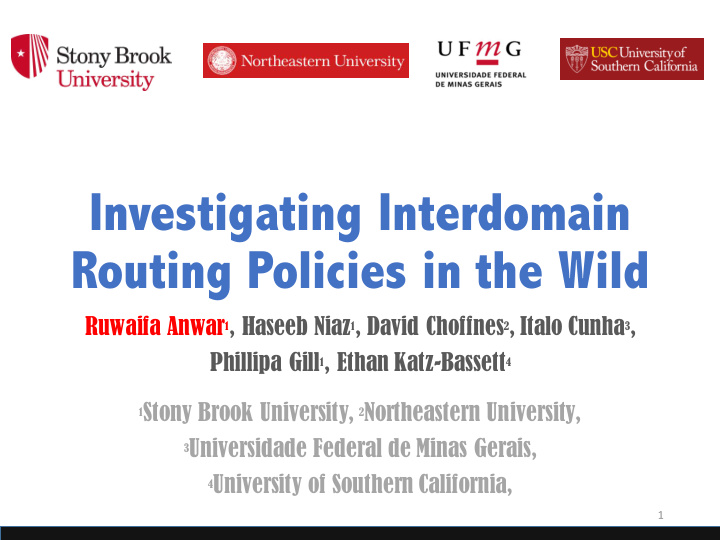



Investigating Interdomain Routing Policies in the Wild Ruwaifa Anwar 1 , Haseeb Niaz 1 , David Choffnes 2 , Italo Cunha 3 , Phillipa Gill 1 , Ethan Katz-Bassett 4 1 Stony Brook University, 2 Northeastern University, 3 Universidade Federal de Minas Gerais, 4 University of Southern California, 1
• How do we innovate in the Internet? • Building new protocols, playing what-if scenarios • Can’t test the ideas straight on the Internet • Might require Internet-wide changes, cause disruptions • Restricts research to today’s Internet deployments • Solution? • Use Internet models to evaluate what would happen Problem solved? • Gao Rexford (GR) Model • ASes connect based on business relationships • Prefer customer > peer > provider path • Pick the one with shortest path length • Export customer paths to all neighbours • Export provider or peer paths to customers only But how well this model hold? Is Gao-Rexford the only model? 2 Ruwaifa Anwar, NRG, Stony Brook University
• Methodology • Ripe Atlas probes from different countries and Ases • Traceroutes towards popular content providers • Compare AS paths with CAIDA’s AS topologies • How many decisions followed GR model? 64.7% of total decisions followed Gao-Rexford • Causes of limitations • Siblings • Prefix specific policies For more details, refer to our paper: • Undersea cables “Investigating Interdomain Policies in the Wild” (IMC’15) • Improvement? RuwaifaAnwar 20% more of the total decisions followed GR manwar@cs.stonybrook.edu • Takeaways Networking Research Group, Stony Brook University, New York • Future models can take into account limitations we observed www.nrg.cs.stonybrook.edu 3 Ruwaifa Anwar, NRG, Stony Brook University
Recommend
More recommend